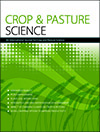Identifiying the molecular mechanisms involved in tolerating phosphorus deficiency and improving phosphorus utilisation efficiency is critical in maize (Zea mays) breeding programs. This study evaluated the genetic basis of phosphorus uptake in 93 maize genotypes using a maize 600K Single Nucleotide Polymorphism (SNP) array followed by gene network analysis. We showed genetic variability in phosphorus uptake in the evaluated maize germplasm and identified the genes that could be used in future breeding programs to develop genotypes that more phosphorus-efficient.

Crop & Pasture Science
Volume 76 Number 4 2025
Finger millet (Eleusine coracana) is a climate-resilient crop and thrives in drought-prone environments through diverse strategies. Morphologically, its robust root system and reduced leaf area enhance water use efficiency. Physiologically, it maintains chlorophyll, photosynthesis, and water content under stress. Biochemically, osmolytes and antioxidant enzymes mitigate oxidative damage, while molecularly, stress-response genes like EcDehydrin7 and EcbZIP60 aid adaptation. This review highlights finger millet’s multifaceted drought tolerance mechanisms, underscoring its potential for breeding resilient crops to address global water scarcity challenges.
This article belongs to the collection: Abiotic Stress Tolerance vs Climate Change.
Wheat farmers are increasingly leaving more stubble standing after harvest, which could affect the spread of plant diseases such Fusarium crown rot (FCR). A new study found that taller cereal stubble allowed the Fusarium fungus to grow further after harvest, potentially increasing disease risk for future crops. Although stubble height did not significantly affect disease in the short term, the research offered valuable insights into how stubble management could help control FCR in the future.
CP24365 Abstract | CP24365 Full Text | CP24365PDF (1.5 MB) | CP24365Supplementary Material (1.9 MB) Open Access Article
Enteric methane (CH4) emission from livestock accounts for 71% of greenhouse gas emissions from Australian agriculture. A range of pasture mixes was evaluated for their compatibility, productivity, feed quality and CH4 emission reduction potential. Pasture species higher in saponins and condensed tannins have great potential to reduce enteric CH4 emissions. Pasture mixes containing plantain and/or biserrula exhibited potential to reduce CH4 emissions, but poor persistence may limit their adoption. Suitable pasture mixes can be deployed to reduce CH4 emission intensity, allowing producers opportunity to decrease their greenhouse gas liability in emission reduction schemes.
This article belongs to the collection: Australian Grasslands Symposium 2025 “Seeds of Change”.
CP24356 Abstract | CP24356 Full Text | CP24356PDF (1 MB) | CP24356Supplementary Material (963 KB) Open Access Article
Brazil is the largest producer of sugarcane (Saccharum officinarum) in the world, which produces sugar, ethanol and energy (biomass). Both climate efficiency and agricultural efficiency (best management practices) are obtained from knowledge of edaphoclimatic variability, both in space (different regions) and in time (phenological phases and cycles). Based on the results of this work, it was possible to identify climatic and soil groups with the best characteristics to obtain higher sugarcane yields.
Soybean (Glycine max) is one of the most important crop, primarily being cultivated as a substitute for high-protein meat and a source of vegetable oil. In recent years, several traditional breeding methods have increased soybean yields but are not able to meet the demands of the world’s rapidly growing population. Therefore, novel genomic techniques are required to overcome those challenges by introducing greater genetic diversity into the soybean germplasm, which will help develop multipurpose desired soybean varieties.
This article belongs to the collection: Plant breeding- and genetics-based tools for food security under changing climate.
Each year, a portion of grain production costs is spent on weed control, causing economic losses, environmental pollution, and health issues. Accurate and rapid weed detection in highly dense conditions using advanced computer vision and artificial intelligence techniques reduces pesticide use. Research results showed that these systems can effectively distinguish crops from weeds, accurately identify their locations, and enable optimal farm management.




